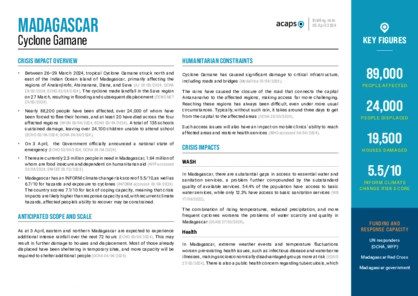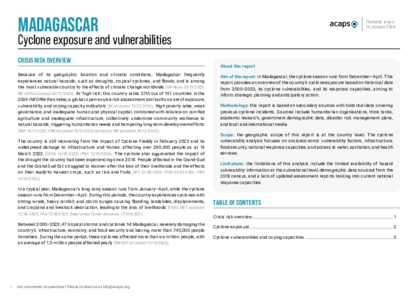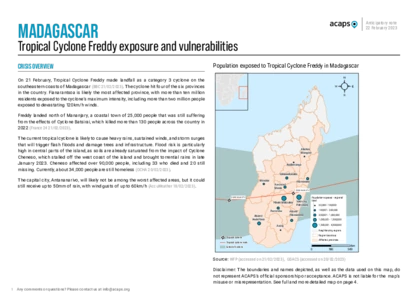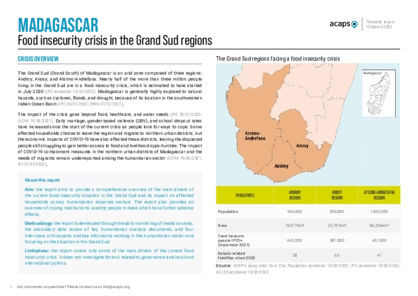Latest updates on country situation
09 September 2025
In Madagascar, food insecurity is expected to worsen as a result of poor harvests driven by climatic shocks and pest and disease attacks, alongside unemployment, high food prices, and inadequate WASH conditions. From May–September 2025, approximately 1.2 million people are projected to experience acute food insecurity of Crisis (IPC Phase 3) or worse levels, with the number rising to 1.5 million by January 2026 and reaching 1.64 million by April 2026. From May 2025 to April 2026, acute malnutrition is expected to affect around 558,000 children and 38,500 pregnant or breastfeeding women. (IPC 09/09/2025, IPC 09/09/2025)
18 March 2025
Tropical Storm Jude made landfall in Madagascar on 8 and 15 March, affecting the Grand Sud regions. The storm brought heavy rainfall, causing fatalities and damage to homes, schools, and roads and hindering humanitarian access. At least 15,000 people were affected, with over 10,000 displaced to temporary sites. Urgent needs include food, WASH, protection, and healthcare.
(OCHA 18/03/2025, ECHO 17/03/2025)
04 March 2025
On 2 March 2025, Cyclone Honde passed near southwestern Madagascar, displacing around 22,000 people, killing three, and injuring 69. It also damaged houses, schools, and roads. By 4 March, those displaced were staying in temporary shelters across districts. Their most urgent needs include food and NFIs, WASH, and medicine. (OCHA 04/03/2025, Lexpress 04/03/2025)
04 February 2025
Between January–April 2025, approximately 1.94 million people (18% of the assessed population) are expected to experience acute food insecurity at Crisis (IPC Phase 3) levels. This is an increase from the previous period (September–December 2024), which saw 1.63 million food-insecure people. The rise is attributed to food price inflation; adverse climatic conditions, including below-average rainfall; cyclones; and floods. The current lean season (typically December–April) has increased household vulnerability, aggravating food shortages. The planting of the main season crop, rice, was also late by several weeks in the southern, central, and eastern regions, which are key agricultural zones. Nationwide, above-average temperatures are forecasted from January–March 2025, compounding the challenges of reduced rainfall. November–April coincides with the cyclone season, which poses a significant threat to crops and agricultural production. Two cyclones, Dikeledi and Chido, have just recently affected Madagascar. Their lingering impacts will further reduce food availability and heighten food insecurity. (IPC 31/01/2025, FAO 27/01/2025)
24 September 2024
In 2024, southern Africa is experiencing its worst drought in 100 years as a result of El Niño. Approximately 61 million people need assistance, with over 20 million experiencing Crisis (IPC Phase 3) food insecurity levels. Botswana, Lesotho, Malawi, Namibia, Zambia, and Zimbabwe have declared a state of emergency in response to the severe drought. There has also been a significant increase in malnutrition cases in Angola, Madagascar, Malawi, Mozambique, and Zambia, with expectations for the trend to continue into the first quarter of 2025. (OCHA 20/09/2024, OCHA 19/09/2024)
02 April 2024
On 27 March 2024, Tropical Cyclone Gamane made landfall in Ampisikinana commune, Sava region. As at 30 March, the cyclone had caused heavy rains and floods, killing 18 people and leading to four people missing. It had displaced over 24,000 people and affected more than 88,000 in Analanjirofo, Atsinanana, Diana, and Sava regions. The displaced were sheltering in 87 temporary shelter sites across these regions. Gamane has also had a significant impact on infrastructure and agriculture, destroying nearly 800 houses and over 100 schools and flooding over 1,600 hectares of rice fields as at 29 March. The collapse of roads and bridges hampers access to the affected areas, with heavy rains cutting off the road connecting the capital to the northeast. The needs of the affected people are uncertain, with assessments still underway. (BNGRC Facebook 30/03/2024, OCHA 28/03/2024, Club of Mozambique 30/03/2024)
06 February 2024
IPC projects that between February–April 2024, around 1.7 million people will experience Crisis (IPC Phase 3) or worse food insecurity levels, including 119,000 facing Emergency (IPC Phase 4) levels, as a result of the lean season (December–April). This is an increase from the previous quarter (October 2023 to January 2024), which registered 1.3 million people facing IPC 3 or worse levels. (IPC 18/01/2024, ACAPS accessed 07/02/2024)
current crises
in
Madagascar
These crises have been identified through the INFORM Severity Index, a tool for measuring and comparing the severity of humanitarian crises globally.
MDG002 - Drought in southern regions
Last updated 28/11/2025
Drivers
Drought/drier conditions
Crisis level
Country
Severity level
2.7 Medium
Access constraints
1.0
Analysis products
on
Madagascar
05 April 2024
Madagascar: Cyclone Gamane
DOCUMENT / PDF / 404 KB
Between 26–29 March 2024, tropical Cyclone Gamane struck north and east of the Indian Ocean island of Madagascar, primarily affecting the regions of Analanjirofo, Atsinanana, Diana, and Sava. Nearly 88,200 people have been affected, over 24,000 of whom have been forced to flee their homes.
19 January 2024
Madagascar: cyclone exposure and vulnerabilities
DOCUMENT / PDF / 861 KB
This report provides an overview of the country’s cyclone exposure based on historical data from 2000–2023, its cyclone vulnerabilities, and its response capacities, aiming to inform strategic planning and anticipatory action.
10 March 2022
Madagascar: Food insecurity crisis in the Grand Sud regions
DOCUMENT / PDF / 575 KB
The report aims to provide a comprehensive overview of the main drivers of the current food insecurity situation in the Grand Sud and its impact on affected households across humanitarian response sectors. The report also provides an overview of coping mechanisms used by people in need, which have further adverse effects.
13 March 2017
Madagascar: Tropical Cyclone Enawo
DOCUMENT / PDF / 542 KB
Tropical Cyclone Enawo, equivalent to a Category 4 hurricane on the Saffir-Simpson scale, made landfall over Antalaha district, in the northeastern coast of Madagascar, on 7 March. As of 13 March, at least 100,000 people have been directly affected by the cyclone, approximately half of whom are in Antalaha district.






